

Summary:
When shoulder or hip pain strikes, imaging tests like ultrasound and MRI can help uncover the cause — from muscle tears to joint inflammation. But which one should you choose? This article explores the strengths and limitations of both ultrasound and MRI, helping you understand which test is most useful depending on your symptoms and clinical needs.
Shoulder and hip pain are among the most common musculoskeletal complaints. They can stem from a wide range of conditions, such as rotator cuff injuries, bursitis, tendinopathy, arthritis, or labral tears.
Because the source of pain isn’t always obvious, imaging is often required to guide diagnosis and treatment.
The two most common scans are ultrasound and MRI (Magnetic Resonance Imaging). Each has unique advantages — and understanding how they differ can help patients and doctors make informed decisions.
An ultrasound scan uses high-frequency sound waves to create real-time images of soft tissues, muscles, and tendons. It’s the same safe technology used in pregnancy imaging and is completely radiation-free.
A handheld probe (called a transducer) is placed on the skin, using a small amount of gel to transmit sound waves. These waves bounce off internal structures, creating moving images on a monitor.
Ultrasound is particularly effective for:
Because ultrasound is performed in real time, it allows clinicians to assess how tissues behave when the joint is moved or stressed — something MRI cannot do.
MRI (Magnetic Resonance Imaging) uses strong magnetic fields and radio waves to generate detailed images of soft tissues, cartilage, ligaments, and bones. Unlike X-rays, MRI doesn’t use radiation and provides an exceptional level of anatomical detail.
MRI can capture deep structures that ultrasound cannot reach, making it ideal for evaluating complex or hidden injuries within the joint.
MRI is especially useful for diagnosing:
MRI is the gold standard when a comprehensive view of the joint’s internal structure is needed.
Ultrasound has many practical benefits, making it a first-line imaging tool in many orthopaedic and sports medicine clinics.
However, ultrasound does have some limitations.
MRI is often considered the “gold standard” for detailed joint imaging because of its clarity and ability to detect a broad range of conditions.
Despite its power, MRI has some downsides:
For shoulder pain, both imaging techniques play valuable roles — but the choice depends on the suspected problem.
Ultrasound is best for:
MRI is best for:
In most cases, ultrasound is the initial scan — with MRI reserved for when symptoms persist or when deeper joint pathology is suspected.
The hip is a deeper joint, surrounded by large muscles and soft tissue, making it more challenging to assess with ultrasound alone.
Ultrasound is best for:
MRI is best for:
MRI gives a more complete view of the internal joint, especially when structural changes or deeper pathologies are suspected.
Often, both tests are complementary — an ultrasound may guide initial diagnosis and treatment, while an MRI confirms deeper findings or evaluates response to therapy.
1. Which scan is more accurate — ultrasound or MRI?
MRI provides more detailed and comprehensive images, especially for deep structures. However, ultrasound is very accurate for tendon and muscle injuries when performed by an experienced clinician.
2. Does ultrasound replace MRI?
Not always. Ultrasound is excellent for dynamic soft tissue evaluation but cannot replace MRI when deep joint or cartilage assessment is needed.
3. Is ultrasound faster than MRI?
Yes. Ultrasound can be performed immediately during a clinic visit, while MRI usually requires scheduling and a longer scan time.
4. Is there radiation in either scan?
No. Both ultrasound and MRI are radiation-free imaging methods.
5. Can I have both ultrasound and MRI?
Yes. Many patients undergo ultrasound first and then MRI if the diagnosis remains uncertain or more detail is required for surgical planning.
6. Which is better for arthritis?
MRI provides a clearer picture of cartilage wear, bone changes, and inflammation. Ultrasound may still be used to monitor inflammation and guide injections.
Both ultrasound and MRI play vital roles in diagnosing shoulder and hip pain.
Ultrasound offers quick, dynamic, and cost-effective insights — ideal for evaluating soft tissue injuries and guiding treatment. MRI, on the other hand, provides in-depth visualization of deeper structures, making it indispensable for complex or persistent joint problems.
If you’re unsure which test is right for you, consult an experienced orthopaedic specialist such as Dr Oliver Khoo, who can recommend the most appropriate imaging based on your symptoms and medical history.
For related articles on joint pain, treatment, and orthopaedic imaging, visit the Oliver Khoo Blog.